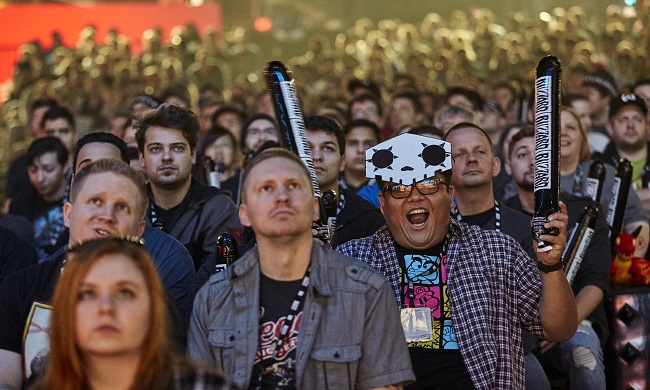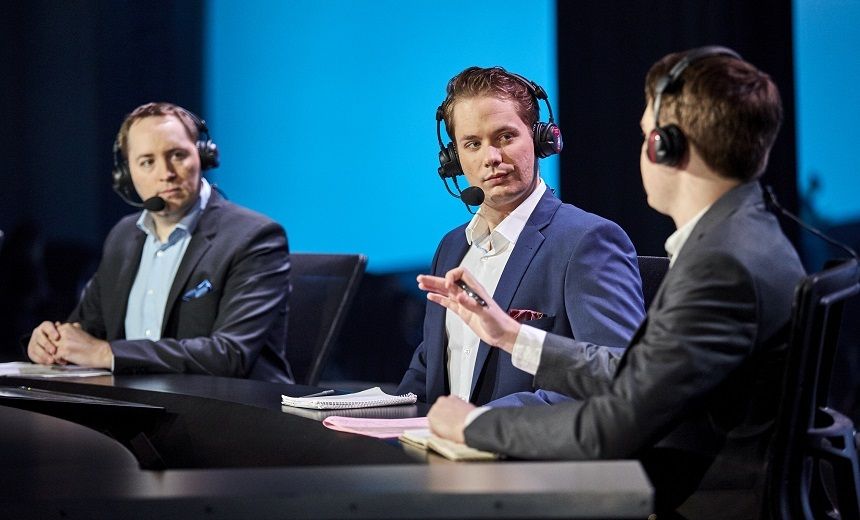
Throughout its first year, Overwatch has received many comments regarding its presentation. Due to the variety of heroes, the chaotic nature of the fights, 3-D environment, and the different angles for spectators, Overwatch can be a difficult game to follow not only for the experienced viewer, but also for the caster. In fact, many top casters agree that Overwatch is currently one of the most difficult Esports to cast. The game is fast paced and action-packed, so it isn’t very easy for a viewer to track everything occurring at once.
A big part of the perceived chaos is there aren’t enough moments of “down-time” where action will be slow enough for the casters to discuss the state of the game. Both in sportscasting and Esports, you’ll generally have one “Play by Play” caster, who narrates the action, covers the teamfight and sets up questions for his co-caster, the “Color” Caster, to offer analysis on. Due to the speed of the game, teamfights occur relatively frequently, making it difficult to cover everything that happened in the preceding moments.
However, there are still ways to include analysis in teamfights.
Matt “Mr X” Morello begins this clip, and after the first pick, he sets up the fight for his co-caster, Mitch “Uber” Leslie, to take over. Uber, “traditionally” a PBP caster, does a fantastic job of blending color casting into his play-by-play.
Uber handles this fight very well. To start off, he lets “the camera do the talking”. Since the vantage point that the Soldier 76 player has covers a large portion of the map, he doesn’t need to describe all the action the viewer is currently seeing. Instead, he describes the narrative of the fight by referring back to how it began and the position it put the teams in.
In many (e)sports, a live replay can be used by a color caster to describe the significance of the starting moment of a play. In this case, this was the Tracer getting picked off. However, many Overwatch productions currently don’t have instant replay functionality, and with the speed of the game, it can be hard to include. Uber refers to the pick and its significance while continuing with the teamfight. Uber starting off his commentary with “Things are going wrong for Soon and Misfits so far, that’s a horrible situation…” sets the tone for the entire segment of the commentary. The viewers are told just how badly the situation is for the defense, and if they were to come out of it standing, it sounds as if it’d be by a miracle.
Not only does Uber refer to the pick that started the fight, but he also references the player, instead of stating simply the hero name. These players and their narratives are a big reason why we watch these games, and naming them often and appropriately is an important way for casters to connect a viewer with a player.

As the fight goes on, the attacking team continues to win the fight, killing the enemy Zenyatta, a high value target. Uber sets up the kill (and again references the player) with “and Hidan is not too far behind now...” There are many reasons why Zenyatta is a high value target for the offense, however Uber simply states “ the Zenyatta is down, no more healing coming from his direction…” That sums up everything a listener needs to know within that short of a time frame. One could give a lecture on the significance of healers and why teams should focus them down early in teamfights. It’s common knowledge that a healer dying first is a big deal. Uber doesn’t have the time for a lecture, he simply has time to note the hero's death and describe what the team now lacks because of it, which the audience will understand so long as they have a decent understanding of the game. That is a perfect example of blending analysis with play-by-play.
The fight continues, and as more of the defense is falling, Uber lowers his tone a little, indicating that the outcome of the teamfight is fairly obvious, and the fight is entering its conclusion. The fight ends a few moments later, with Misfit’s defense falling after the initial pick and subsequent aggression of Fnatic’s offense. A number of things occurred during the fight, and there were many things Uber could have focused on, but without the luxury of an instant replay to use for analysis, he expertly set the tone of the fight, analyzed the death of key players, and remained excited throughout its duration.
Not many casters would have handled that fight in that way. Some would opt to focus on the Soldier and his targets, which would be more “PBP” focused, but lose some of the analysis and story of why that fight was so compelling. Others may simply have focused on the killfeed, rattling off all of the deaths in succession. Overwatch’s best casters are able to create storylines and educate a viewer, all while describing the action of the game and entertaining the audience.

Even though top casters are able to blend moments of educational commentary into their PBP, the game moves at such a fast pace that certain aspects of beautiful teamfights simply cannot be “explored” live. For example, in the clip shown, the Soldier and his team have great positioning. That positioning (unfortunately) isn’t referenced at all. During the Overwatch World Cup, instant replays were commonly used during the downtime in between fights.
Instant Replays are an excellent way for casters to go over details they not have mentioned during the fight, however it can be incredibly difficult to obtain those within the right timeframe. In Overwatch, after a teamfight is over, there will only be a brief respite before the teams meet up together, clashing over yet another objective. For a replay operator, there will often not be enough time for them to find the replay, and bring it up for the casters before the next fight begins. Still, there are a lot of changes that can make obtaining replays and the pacing of the game more enjoyable for viewers and casters alike.
The intensity and speed at which Overwatch is played is a part of the reason why it’s exciting. The game is fast, the action gets intense and varied. A viewer can be excited about an individual destroying a team with incredible headshots, or when his favorite team wipes the enemy with beautifully coordinated ultimates. However, all the aspects that make the game entertaining as an esport also make it a difficult beast to cast, and observe. In my next piece I’ll discuss some different casting styles, and take a look at how casters are specifically tailoring their casting style to best present the game. In my following piece I’ll take a look at other changes - to the game itself and its production, that can help it become a more compelling Esport.
For more competitive Overwatch news and features, follow us @GosuOverwatch.
 |
Seamus 'Seamoose' Anderson is a passionate contributor to the Overwatch Scene Seamus got his start in Overwatch as an analyst and coach for Team Method. He's also held a variety of community positions, including BlizzCon Directing Observer for Overwatch and caster for the TESPA Collegiate Overwatch scene You can find him on Twitter @Seamoose1 |

